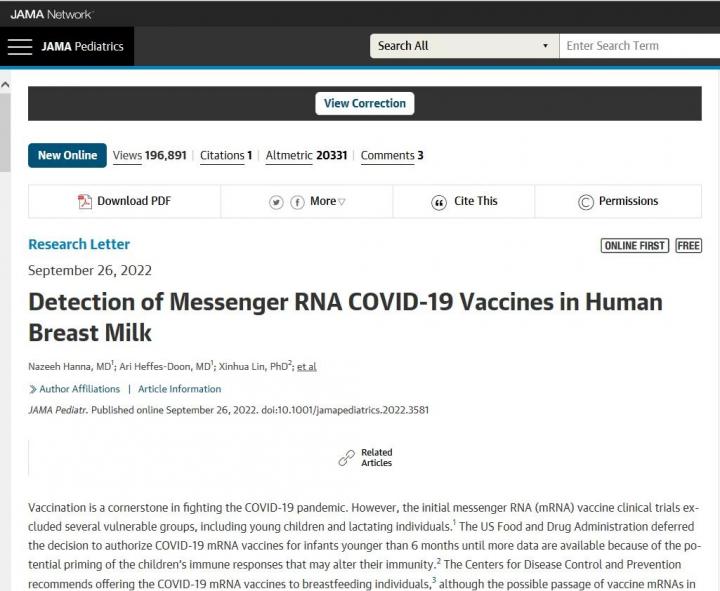★そろそろ、専門家風の根拠無き与太話や政府を含めた権威筋に、謂れも無く平伏すだけの態度は終わりにしたらどうか。
母乳を通じて母親から赤ちゃんへメッセンジャーRNAコロナワクチンが移行する事、が医学誌で確認されたそうだ。
・ワクチンを打たないのは、反社会的行為だ
・ワクチン接種を受けるのは、自分の為だけでなく他の人の為でもあり、社会全体の為でもある
これ等の「孫の為」「祖父母の為」「子供の為」という"神話"に翻弄され、日本中でどれ程の人達がワクチン接種を余儀なくされた事か。
★世界最大級にして米国医師会誌であるJAMAに「母乳を通じて母親から乳児にCOVIDワクチンのmRNAが移行する」事を突き止めた論文が発表された(エビデンス有りの専門家・権威筋)。
・既にCDCのワクチン有害事象報告(VAERS)には、授乳による曝露での赤ちゃんの副作用事例が多数報告されてる。
★喫緊の課題は、これ等の事象を如何に受け止め(思考・解釈し)、どう行動に反映するかだと思うのだが・・・。
論文概要:
然しながら、最初のメッセンジャーRNAワクチンの臨床試験では、幼い子供や授乳中の個人など、幾つかの脆弱なグループが除外されました。
米国食品医薬品局は、6ヶ月未満の乳児にCOVID-19mRNAワクチンを認可する決定を、より多くのデータが利用可能になるまで延期しました。
疾病管理予防センターは、COVID-19mRNAワクチンを授乳中の個人に提供することを推奨しています。ただし、乳児が6ヶ月未満で曝露する原因となる母乳中のワクチンmRNAの通過の可能性については調査されていません。
この研究では、COVID-19ワクチンのmRNAが、出産後6ヶ月以内にワクチン接種を受けた授乳中の個人の搾乳母乳から検出出来るかどうかを調査しました。
そして、出産後6ヶ月以内にワクチン接種をした11人の健康な授乳中の女性が含まれています。
結果:
登録された11人の授乳中の個人の内、微量の BNT162b2 および mRNA-1273 COVID-19 mRNA ワクチンが、ワクチン接種後45時間までの様々な時点で、5人の異なる参加者からの7つのサンプルで検出されました。
搾乳母乳から分離された細胞外小胞(EV)の平均収量は 9.1粒子/mL であり、平均の粒子サイズは 110.0 nm でした。ワクチンの mRNAは、全乳よりも細胞外小胞で高濃度で現れます。
ワクチン mRNA は、ワクチン接種前またはワクチン接種後の搾乳母乳サンプルで、採取から48時間を超えて検出されませんでした。また、搾乳母乳の脂肪画分または、搾乳母乳の細胞ペレットから COVID-19 ワクチンの mRNA は検出されませんでした。
Detection of Messenger RNA COVID-19 Vaccines in Human Breast Milk
September 26, 2022
Vaccination is a cornerstone in fighting the COVID-19 pandemic. However, the initial messenger RNA (mRNA) vaccine clinical trials excluded several vulnerable groups, including young children and lactating individuals.1 The US Food and Drug Administration deferred the decision to authorize COVID-19 mRNA vaccines for infants younger than 6 months until more data are available because of the potential priming of the children's immune responses that may alter their immunity.2 The Centers for Disease Control and Prevention recommends offering the COVID-19 mRNA vaccines to breastfeeding individuals,3 although the possible passage of vaccine mRNAs in breast milk resulting in infants' exposure at younger than 6 months was not investigated. This study investigated whether the COVID-19 vaccine mRNA can be detected in the expressed breast milk (EBM) of lactating individuals receiving the vaccination within 6 months after delivery.
Methods
This cohort study included 11 healthy lactating individuals who received either the Moderna mRNA-1273 vaccine (n = 5) or the Pfizer BNT162b2 vaccine (n = 6) within 6 months after delivery (Table 1). Participants were asked to collect and immediately freeze EBM samples at home until transported to the laboratory. Samples of EBM were collected before vaccination (control) and for 5 days postvaccination. A total of 131 EBM samples were collected 1 hour to 5 days after vaccine administration. Extracellular vesicles (EVs) were isolated in EBM using sequential centrifugation, and the EV concentrations were determined by ZetaView (Analytik) (eMethods in the Supplement). The presence of COVID-19 vaccine mRNA in different milk fractions (whole EBM, fat, cells, and supernatant EVs) was assayed using 2-step quantitative reverse transcriptase-polymerase chain reaction. The vaccine detection limit was 1 pg/mL of EBM (eMethods in the Supplement).
Results
Of 11 lactating individuals enrolled, trace amounts of BNT162b2 and mRNA-1273 COVID-19 mRNA vaccines were detected in 7 samples from 5 different participants at various times up to 45 hours postvaccination (Table 2). The mean (SD) yield of EVs isolated from EBM was 9.110 (5.010) particles/mL, and the mean (SD) particle size was 110.0 (3.0) nm. The vaccine mRNA appears in higher concentrations in the EVs than in whole milk (Table 2). No vaccine mRNA was detected in prevaccination or postvaccination EBM samples beyond 48 hours of collection. Also, no COVID-19 vaccine mRNA was detected in the EBM fat fraction or the EBM cell pellets.
Discussion
The sporadic presence and trace quantities of COVID-19 vaccine mRNA detected in EBM suggest that breastfeeding after COVID-19 mRNA vaccination is safe, particularly beyond 48 hours after vaccination. These data demonstrate for the first time to our knowledge the biodistribution of COVID-19 vaccine mRNA to mammary cells and the potential ability of tissue EVs to package the vaccine mRNA that can be transported to distant cells. Little has been reported on lipid nanoparticle biodistribution and localization in human tissues after COVID-19 mRNA vaccination. In rats, up to 3 days following intramuscular administration, low vaccine mRNA levels were detected in the heart, lung, testis, and brain tissues, indicating tissue biodistribution.4 We speculate that, following the vaccine administration, lipid nanoparticles containing the vaccine mRNA are carried to mammary glands via hematogenous and/or lymphatic routes.5,6 Furthermore, we speculate that vaccine mRNA released into mammary cell cytosol can be recruited into developing EVs that are later secreted in EBM.
The limitations of this study include the relatively small sample size and the lack of functional studies demonstrating whether detected vaccine mRNA is translationally active. Also, we did not test the possible cumulative vaccine mRNA exposure after frequent breastfeeding in infants. We believe it is safe to breastfeed after maternal COVID-19 vaccination. However, caution is warranted about breastfeeding children younger than 6 months in the first 48 hours after maternal vaccination until more safety studies are conducted. In addition, the potential interference of COVID-19 vaccine mRNA with the immune response to multiple routine vaccines given to infants during the first 6 months of age needs to be considered. It is critical that lactating individuals be included in future vaccination trials to better evaluate the effect of mRNA vaccines on lactation outcomes.

